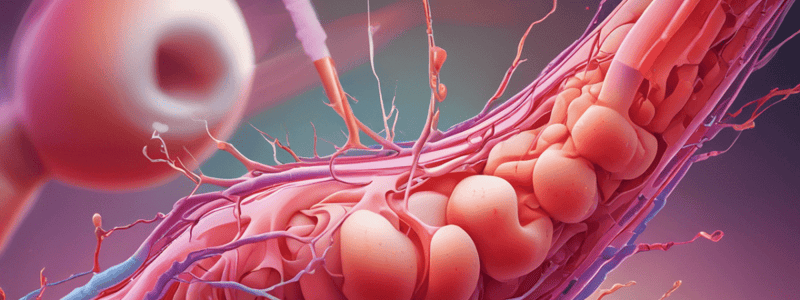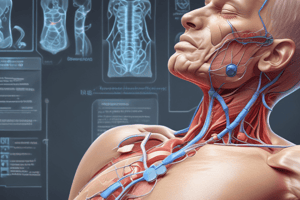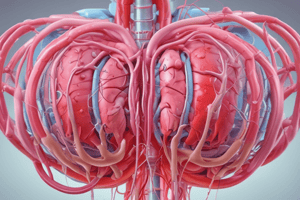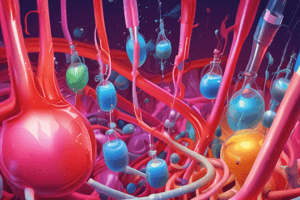Podcast
Questions and Answers
Match the following respiratory intervention with its description:
Match the following respiratory intervention with its description:
Pursed-lip breathing = Technique to alleviate dyspnea by exhaling slowly through pursed lips Incentive spirometer = Device used to encourage deep breathing and prevent lung complications Bronchodilators = Medications that reduce bronchospasm and open congested airways Anti-inflammatories = Medications that decrease edema and inflammation in the airways
Match the respiratory medication with its primary function:
Match the respiratory medication with its primary function:
Sympathomimetic drugs = Reduce bronchospasm and facilitate ventilation Xanthines = Reduce bronchospasm and facilitate ventilation Expectorants = Help break up mucus for easier expectoration Anti-inflammatories = Decrease edema and inflammation in the airways
Match the medication administration route with the preferred method to prevent systemic side effects:
Match the medication administration route with the preferred method to prevent systemic side effects:
Oral administration = May cause systemic side effects Intravenous administration = May cause systemic side effects Inhalation administration = Preferred to prevent systemic side effects Topical administration = Preferred to prevent systemic side effects
Match the technique with the correct description:
Match the technique with the correct description:
Match the following actions with their purpose in respiratory care:
Match the following actions with their purpose in respiratory care:
Match the following with their respective descriptions: Sputum and throat culture specimens
Match the following with their respective descriptions: Sputum and throat culture specimens
Match the following with their respective descriptions: Arterial blood gases
Match the following with their respective descriptions: Arterial blood gases
Match the following with their respective descriptions: Pulmonary function tests
Match the following with their respective descriptions: Pulmonary function tests
Match the following with their respective descriptions: X-rays and lung scans
Match the following with their respective descriptions: X-rays and lung scans
Match the following with their respective descriptions: Bronchoscopy
Match the following with their respective descriptions: Bronchoscopy
Match the following terms with their definitions:
Match the following terms with their definitions:
Match the following terms with their descriptions:
Match the following terms with their descriptions:
Match the following terms with their effects on the body:
Match the following terms with their effects on the body:
Match the following terms with their impact on lung health:
Match the following terms with their impact on lung health:
Match the following terms with their diagnostic tools:
Match the following terms with their diagnostic tools:
Match the diagnostic study with its description:
Match the diagnostic study with its description:
Match the diagnostic study with its outcome:
Match the diagnostic study with its outcome:
Match the diagnostic study with its purpose:
Match the diagnostic study with its purpose:
Match the diagnostic study with its method:
Match the diagnostic study with its method:
Match the diagnostic study with its application:
Match the diagnostic study with its application:
Match the following procedures with their purpose:
Match the following procedures with their purpose:
Match the following actions with their effects:
Match the following actions with their effects:
Match the following outcomes with their causes:
Match the following outcomes with their causes:
Match the following practices with their benefits:
Match the following practices with their benefits:
Match the following diagnostic tools with their purposes:
Match the following diagnostic tools with their purposes:
Match the assessment parameter with the correct description:
Match the assessment parameter with the correct description:
Match the clinical sign of hypoxemia with its description:
Match the clinical sign of hypoxemia with its description:
Match the low-flow oxygen administration device with its description:
Match the low-flow oxygen administration device with its description:
Match the lung assessment parameter with its description:
Match the lung assessment parameter with its description:
Match the following medical procedures with their descriptions:
Match the following medical procedures with their descriptions:
Match the following diagnostic tests with their characteristics:
Match the following diagnostic tests with their characteristics:
Match the following medical imaging techniques with their applications:
Match the following medical imaging techniques with their applications:
Match the following imaging procedures with their features:
Match the following imaging procedures with their features:
Match the following pulmonary tests with their purposes:
Match the following pulmonary tests with their purposes:




